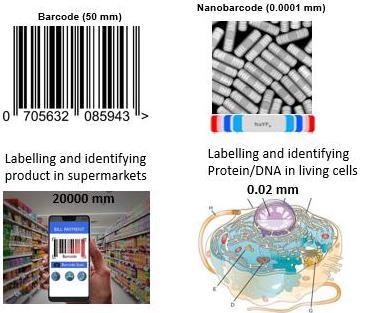Dec 1 2020
The use of barcodes to label and recognize day-to-day items is quite usual similar to a trip to the supermarket. What if those barcodes are shrunk a million times, from millimeter to nanometer scale, to enable their use within living cells to label, recognize, and monitor the building blocks of life, or mixed with inks to avoid counterfeiting.
 Imagine shrinking those barcodes a million times, from millimeter to nanometer scale, so that they could be used inside living cells to label, identify, and track the building blocks of life, or blended into inks to prevent counterfeiting. Image Credit: University of Technology Sydney.
Imagine shrinking those barcodes a million times, from millimeter to nanometer scale, so that they could be used inside living cells to label, identify, and track the building blocks of life, or blended into inks to prevent counterfeiting. Image Credit: University of Technology Sydney.
This forms the frontier of nanoengineering, which involves the fabrication and controlled regulation of nanostructures at the atomic level—a new, basic study, published in the Nature Communications journal, demonstrates the opportunities and chances ahead.
A research collaboration led by the University of Technology Sydney (UTS) developed a nanocrystal growth technique that involves regulating the growth direction to synthesize programmable atomic thin layers and arbitrary barcoded nanorods, with uniform morphology.
The outcome is millions of diverse nanobarcodes that can constitute a “library” for future nanoscale sensing applications.
The team expects that these barcode structures will gain wide interests in various applications as nanocarriers of information for data storage, life sciences, and bio-nanotechnology, once they are integrated into a range of matrices.
According to Dr Shihui Wen, lead author of the study, the study offers a benchmark that will unlock the ability to design smaller nanophotonics devices.
The inorganic nanobarcode structures are rigid, and it is easy to control the composite, thickness and distance accuracy between different functional segments for geometrical barcoding beyond the optical diffraction limit.
Dr Shihui Wen, Study Lead Author, Institute of Biomedical Materials and Devices, University of Technology Sydney
“Because they are chemically and optically stable, the nanoscopic barcodes can be used as carriers for drug delivery and tracking into the cell, once the surface of the barcode structures is further modified and functionalized with probe molecules and cargos,” added Dr Wen.
Moreover, the researchers achieved another innovation with the creation of a novel, tandem decoding system that uses super-resolution nanoscopy to characterize diverse optical barcodes inside the diffraction limit.
Professor Dayong Jin, Director of the UTS Institute of Biomedical Materials and Devices (IBMD) and senior author of the study, stated that this kind of super resolution imaging cannot be performed by any existing commercial system.
We had to build the instrumentation to diagnose the sophisticated functions that can be intentionally built into the tiny nanorod. These together allow us to unlock the further potential for placing atomic molecules where we want them so we can continue to miniaturise devices. This was the first time we were able to use super resolution system to probe, activate and readout the specific functional segment within the nanorod.
Dayong Jin, Director, Institute of Biomedical Materials and Devices, University of Technology Sydney
Jin, who is also the co-director of UTS-SUStech Joint Research Centre, continued, “Imagine a tiny device, smaller than one thousandth the width of a human hair, and we can selectively activate a particular region of that device, see the optical properties, quantify them. This is the science now showing many new possibilities.”
The team hopes that the developed nanoscale optical devices could be utilized concurrently to tag various cellular species.
These devices are also readily applicable for high-security-level anticounterfeiting when different batches of them are blended with inks and can be readily printed on high-value products for authentication.
Dr Shihui Wen, Study Lead Author, Institute of Biomedical Materials and Devices, University of Technology Sydney
Journal Reference
Wen, S., et al. (2020) Nanorods with multidimensional optical information beyond the diffraction limit. Nature Communications. doi.org/10.1038/s41467-020-19952-x.